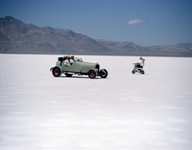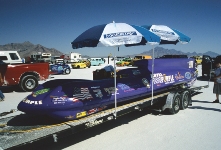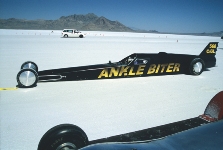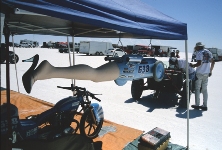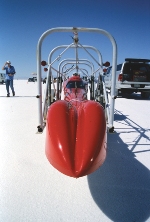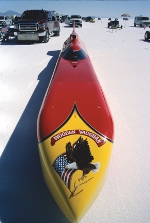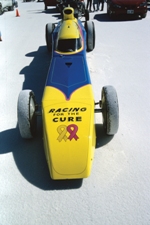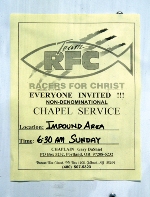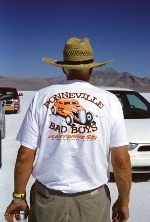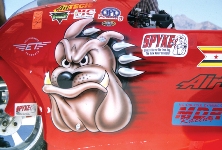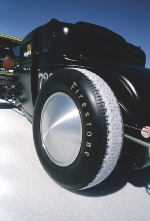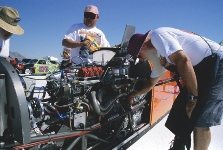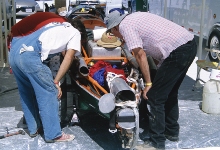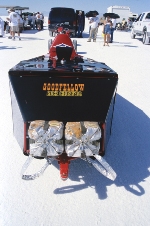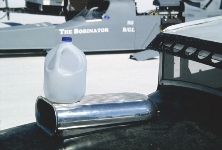Spring/Summer 2008, Volume 24.3
Essay & Art

Michael Wutz
From Salt to Struts and Flats to Fenders—An Unnaturally Natural Combination
Michael Wutz (PhD, Emory University) teaches in the English Department at Weber State University and is the editor of Weber. He is the co-editor of Reading Matters: Narrative in the New Media Ecology (with Joseph Tabbi, Cornell UP, 1997), the co-translator of Friedrich Kittler’s Gramophone, Film, Typewriter (with Geoffrey Winthrop-Young, Stanford UP, 1999), and the author of numerous essays on American and British fiction. Currently, he is at work on a book tentatively entitled "Mediating Narrative. Literary Case Studies in the New Media Ecology." He is an old-fashioned photographer and, though not a speed demon himself, enjoys the ascetic beauty of the Salt Flats and of streamlined design.
The Bonneville Salt Flats are a remnant of the prehistoric Lake Bonneville, encompassing roughly a 160-square-mile expanse in northwestern Utah. Essentially a hard and solid salt deposit, the thick surface is inhospitable to plant life and nearly congruous with the curvature of the Earth. "Out there," on a horizon that is as infinite as it is surreal, the vanishing point of land and sky never meets, which is why the mountain ranges surrounding the Salt Flats often appear floating in the air. As with the oceans, the sea of salt—the leftovers of water—seems to carry these stony icebergs on shimmering waves of air, as brown rock, white salt, and blue sky meld into a color scheme all the more bedazzling because of its unnaturally natural combination.
[Click on photos to enlarge.]
This unnaturally natural combination is paradoxically mesmerizing because its stark beauty resists human habitation and settlement. It is mesmerizing as well because the infinite expanse of surface makes for little friction and engenders dreams of limitlessness. If the mantra of visionaries and engineers, "the sky is the limit," ever needed a geographic analogue, you’d have it in the Salt Flats. Humans, for that reason, have been drawn to the Flats in their pursuit of speed for more than a century and—as if throwing a gauntlet at Nature’s salty feet—have declared the Flats an ideal testing site for the velocity of vehicles.
Historically, it is significant that even the locomotive—that engine of Western expansion—traversed the Salt Flats at various locations and thus ushered in the association of salt with the speedy coverage of distance, however modest. The behemoth weight of the Iron Horse, of course, allowed passage of the Flats only on trellised tracks, but by the end of the nineteenth century the thrill of railroad travel gave way to something new: the search for speed as sport, as a leisure time activity when speed—by some accounts, paradoxically—was not of the essence. What was once a need for speed out of geographical necessity became an urge for the delirium of velocity, a psychological need to conquer time and space with bicycles and, eventually, cars. At that historical moment, riders of assorted vehicles began making their pilgrimage to the Flats to test their and their machine’s mettle on the ribbon of salt.
Today, of course, Interstate 80 delivers a steady trickle of cars through this sun-blistered and seemingly endless sea of white. Monoplanes and paragliders buzzing like noisy gnats through the infinite blue use the Flats for takeoff and landing. What is more, ever since the beginning of serious racing on the Flats in the 1930s, cars and motorcycles have resembled rockets and projectiles more than they have horseless carriages and utility vehicles, as if wanting to close the feedback loop between salty surface and supersonic speed (and car missiles typically deploy chutes to slow down after a run). Foot prints and tire tracks, ephemeral as they are, have unwittingly inscribed into the frail Flats the history of humanity’s attempt to break the speed of sound on land. The human effort to transcend physical limits and material constraints through technology on a stretch of Earth inimical to most forms of life could find no better embodiment. During SpeedWeek, a spectator looking down on the Flats’ lunar landscape might marvel at this mirage of material transcendence.
Indeed each August for roughly 60 years now, the Bonneville Salt Flats morph from a desolate expanse in Western Utah to what is often considered the hot-rodding hub of the world. What Moab in Southeastern Utah is to mountain bikers, the Flats are to motorized speed demons on two or four wheels, or anything in between. Other well-known high-speed venues exist as well, such as El Mirage Dry Lake in California’s Mojave Desert, Lake Gairdner in central South Australia, or the Black Rock Desert in northwestern Nevada; none, however, quite have the sound and mystique of the Bonneville Salt Flats. It all began, if you want to pinpoint a foundational moment, with legendary hot-rodder Sir Malcolm Campbell—think a knighted Evel Knievel, and you get the picture—who gave the area its first international cachet in the 1930s by breaking numerous land speed records. (In the early days often measured in random fashion, land speed records today are standardized as the speed over a course of fixed length, averaged over two runs in opposite directions.) He also bestowed the name "Bonneville" to Triumph’s famous line of motorcycles, a designation that would soon be echoed in the Pontiac Bonneville and become, for a while at least, synonymous with superior speed and engineering.
[Click on photos to enlarge.]
Another milestone were the land speed records of Craig Breedlove, the son of a motion picture special effects specialist and a studio dancer (who worked with Fred Astaire and Ginger Rogers)—two occupations with more than a passing resemblance to motion, sensation, and speed. Breedlove earned his wings—the wings of Hermes, in this instance—as a structural engineering technician at Douglas Aircraft in Santa Monica, California, which allowed him to develop the design and engineering skills to build faster cars. With his first "Spirit of America," which ran on three wheels and was powered by a Korean War military surplus jet engine he purchased for $500, he propelled himself to instant fame and myth by being the first human, in 1963, to drive at a sustained speed of over 400 mph on the Salt Flats—407 mph, to be exact. Breedlove would repeat this feat several times over his career with yet more high-powered prototypes, eventually, in 1965, clocking in as the first human to break the 500 mph speed-on-land record, and the 600 mph barrier shortly afterwards, if only for an instant (the official time was given as 600.601/mph).
[Click on photos to enlarge.]
Keeping up with such speed is difficult, but at the moment, it seems, the current land speed record stands at 763 mph and is held by the British "pilot" Andy Green, the apt appellation for drivers steering ground-bound flying machines perpetually on the verge of taking off. Green is, in fact, a "real" RAF pilot as well and, by all accounts, was the first to break the sound barrier in his twin jet-engine powered Thrust Super Sonic Car. Breedlove, in the meantime, after a long breather from high-speed racing, is working on a turbo-powered, third-generation "Spirit of America" model and is said, in his seventies, to envision breaking the laws of physics and setting a new 800 mph land speed record. In a competition that lends itself to media hype and overtones of national pride not unlike the America’s Cup or Wimbledon, Breedlove has vowed to bring the record home to America by driving again on American soil. As it turns out, speedeonauts and their teams (sometimes, indeed, only clad in a Speedo) have of late opted for Nevada’s Black Rock Desert, a prehistoric dry alkali lake bed north of Reno, to conduct record-breaking trials. The fact that much of the media blitz surrounding Breedlove’s more recent work, however, such as the unveiling of his newest desert craft—this one equipped with solid carbon glass tires—was staged at the Bonneville Salt Flats, instead of in Nevada, testifies to the hallowed grounds of the Bonneville Salt Flats, a ground that appears to be highly fertile for myths of speed and design, if for little else.
[Click on photos to enlarge.]
When walking, slowly, through the line of cars waiting for their first run, as my family and I did in August of 2006, at the beginning of the Bonneville 58th SpeedWeek, speed and records indeed recede into the background. Mistakenly known as a gruff cadre of technophiles with little patience for automotive landlubbers like us, the mechanics, engineers, and pilots, as they were performing last minute checks and tune-ups, were noticeably friendly and eager to answer our pedestrian questions. Contrary to the very nature of the event, the aesthetic beauty of many of the vehicles becomes most visible when they are most immobilized and rendered stationary (often still mounted on blocks or, more commonly, on specially designed hangers, as the cars are not licensed to drive on regular roads and must be hauled onto the Flats). Only when the vehicles are in a state of suspended animation can the viewer’s eye take in the streamlined elegance of high-tech automobiles, as they bask their phallic and metallic bodies in the glistening sun. Similarly, the paint jobs that meld into monochromatic streaks when cars-cum-rockets hurl themselves down the distant race tracks, reveal their intricacy and cleverness only in the parking area. What to the unsuspecting eye may appear to be an eclectic collection of outlandish one-of-a-kinds is, in actuality, a strict manifestation of the principles of modernist architecture and aerospace engineering: form follows function to a T, with not a single random rivet or superfluous screw (unless, which is not unusual either, the snazzy and hulky appearance of a design takes precedence over speed). On the surface of the vehicles, as well as under the proverbial hood—though these hoods often merge seamlessly with the driver’s cabin into supersized shiny body gloves—every design decision is made in the service of minimizing friction and wind resistance.
[Click on photos to enlarge.]
Upon first sight, therefore, a stroll through the line-up of vehicles suggests a walk through an updated Futurist sculpture garden, the tiny group of avant-garde artists coming out of Italy who proclaimed the beauty of speed and the "famished roar of automobiles" at the beginning of industrial modernity. Looking at the bizarre bazaar of designs assembled on the Flats, one is indeed reminded of the bold visions of Futurist paintings, as they pictured sleek vehicles burrowing their way through the billowing air. Such paintings already point to the design teams of Ettore Bugatti and Enzo Ferrari later in the century and, on this side of the Atlantic, to John De Lorean, who were building what a commercial jingle today bills as "the ultimate driving machine" for higher-end mainstream consumers. On the Bonneville Salt Flats, however, that is only part of the story. While SpeedWeek hosts many of the most famous design teams in the world of automobiles—teams often underwritten by major corporate sponsors—the Flats are also a haven for backyard tinkerers and amateur car builders hammering and welding away at their own designs. Just as old timers and cutting-edge aerospace machines—designed or taken out of mothballs for just the occasion, respectively—often cross paths on the Flats, so full-time professional design teams wield their tools in pits next to autodidactic automobilers. In their single-minded pursuit of speed, they all variously embody the quintessentially American notion of individual self-realization, here further accentuated through the, equally American, dialectic of Nature and Technology. Fuselage-like cars on a crusty desert floor may not exactly be the machines of culture plowing the mythical garden that is America, but they nevertheless inscribe an opposition that has been firing the American imagination since its very foundations.
These days, generations of salt mining and land (mis)use have left not only tire tracks on the Flats, but a more literal imprint as well. What once used to be a thick caking of crystallized salt to a depth of up to 6 feet, has these days often dwindled to a brittle surface measuring no more than a couple of inches. In an effort to stop this erosion, Intrepid Potash, the mining company currently harvesting the salt from the Great Salt Lake, has begun cooperating with the Bureau of Land Management to restore and maintain the thickness of the Flats. Beginning in 1997, in an operation akin to reforestation efforts in the Pacific Northwest and elsewhere, the company in the winter pumps liquefied salt onto the Bonneville Salt Flats. Taken from old salt ponds and dissolved with brackish well water, the resultant brine is like a bittersweet sugar coating or witches’ brew giving the Flats a new lease on life. As the heat from the sun evaporates the water over the course of spring and summer, the salt resolidifies and refinishes the rundown surface of the race tracks. To date, close to 9 million tons of salt have been pumped onto the Salt Flats, not only ensuring fragile ecosystems and unique geologic characteristics, but also that the Flats, while submerged for part of the year, remain afloat in America’s techno-mythic imagination.

